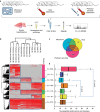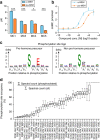Analytic framework for peptidomics applied to large-scale neuropeptide identification
- PMID: 27142507
- PMCID: PMC4857386
- DOI: 10.1038/ncomms11436
Analytic framework for peptidomics applied to large-scale neuropeptide identification
Abstract
Large-scale mass spectrometry-based peptidomics for drug discovery is relatively unexplored because of challenges in peptide degradation and identification following tissue extraction. Here we present a streamlined analytical pipeline for large-scale peptidomics. We developed an optimized sample preparation protocol to achieve fast, reproducible and effective extraction of endogenous peptides from sub-dissected organs such as the brain, while diminishing unspecific protease activity. Each peptidome sample was analysed by high-resolution tandem mass spectrometry and the resulting data set was integrated with publically available databases. We developed and applied an algorithm that reduces the peptide complexity for identification of biologically relevant peptides. The developed pipeline was applied to rat hypothalamus and identifies thousands of neuropeptides and their post-translational modifications, which is combined in a resource format for visualization, qualitative and quantitative analyses.
Conflict of interest statement
Novo Nordisk has commercial interest in neuropeptides for the treatment of diabetes and obesity. A.S., K.W.C.-F., C.P., K.R. and B.S.W. are full-time employees of Novo Nordisk and hold minor share portions as part of their employment. J.V.O. consults for and has research funding from Novo Nordisk. C.D.K. consults for Novo Nordisk.
Figures




References
-
- Hokfelt T., Bartfai T. & Bloom F. Neuropeptides: opportunities for drug discovery. Lancet Neurol. 2, 463–472 (2003). - PubMed
-
- Skold K. et al.. A neuroproteomic approach to targeting neuropeptides in the brain. Proteomics 2, 447–454 (2002). - PubMed
-
- Yamaguchi H. et al.. Peptidomic identification and biological validation of neuroendocrine regulatory peptide-1 and-2. J. Biol. Chem. 282, 26354–26360 (2007). - PubMed
Publication types
MeSH terms
Substances
LinkOut - more resources
Full Text Sources
Other Literature Sources
Molecular Biology Databases

